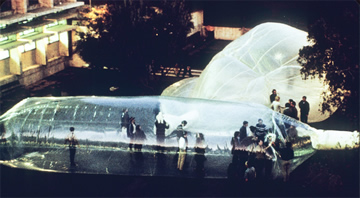Design Takes to the Streets
 |
|
(photo: James Campe) |
They popped up one day alongside UC Berkeley's architecture school—immense plastic inflatable tubes. Foreboding-looking men in Hazmat suits accosted passersby, warning of an "air emergency." Get inside, they warned, or die of toxic pollution.
On Wednesday, February 26, Greg Castillo and Sabrina Richard, curators of the upcoming exhibit ‘Design Radicals' at the university's College of Environmental Design, will discuss the political art of the 1960s counter-culture which, as professor Castillo notes, lasted from 1960 to 1973. The event, sponsored by Shaping San Francisco, starts at 7:30PM at 518 Valencia Street, in San Francisco.
Berkeley and its environs, from Esalen to the hippie communes of Marin, were in the forefront of a design revolution, Castillo says, that was rooted in the Bay Area tradition of "junk and funk." It was "a radical recycling of cast-off objects, turning them into objects that demand to be looked at as something refined, something different."
Castillo says the exhibit was inspired by the Occupy Movement, whose art shows a similar flavor.
The 1960s' work included political posters, the sustainable Integral Urban House, performance art by Anna Halprin, and the Ant Farm collective, which created Berkeley's "air emergency."
Art of the design radicals, Castillo says, was "a rejection of one fundamental tenet of mid-century modernism, which was to try to use aesthetics to redeem the mass consumer culture of the postwar world. These artists were turning away entirely from the mass consumer culture."
For more on 'Design Radicals,' click here.




